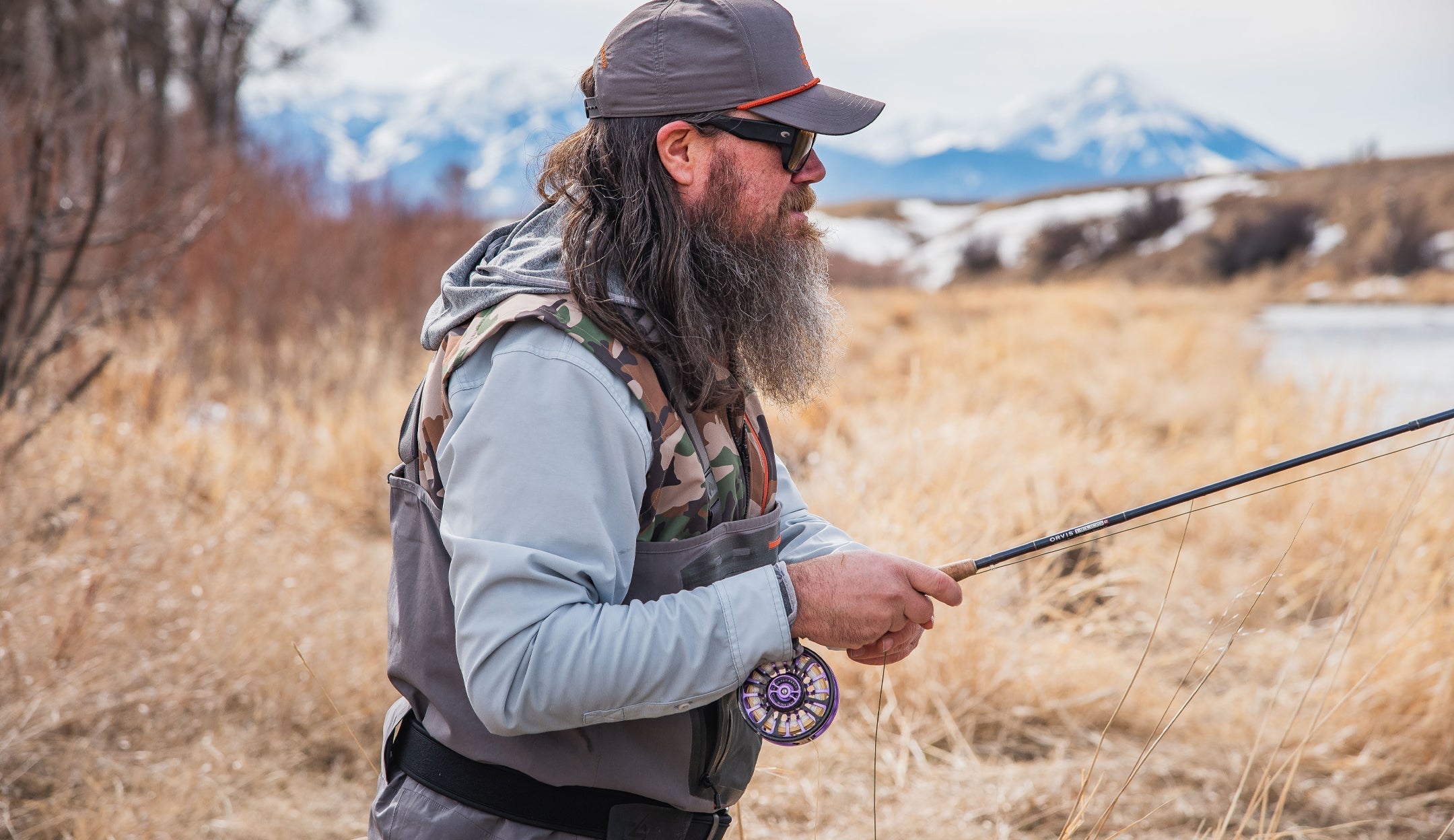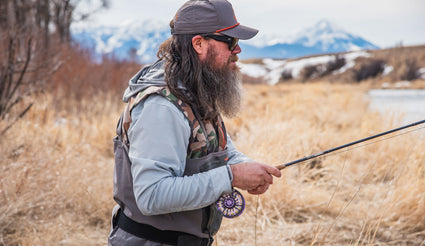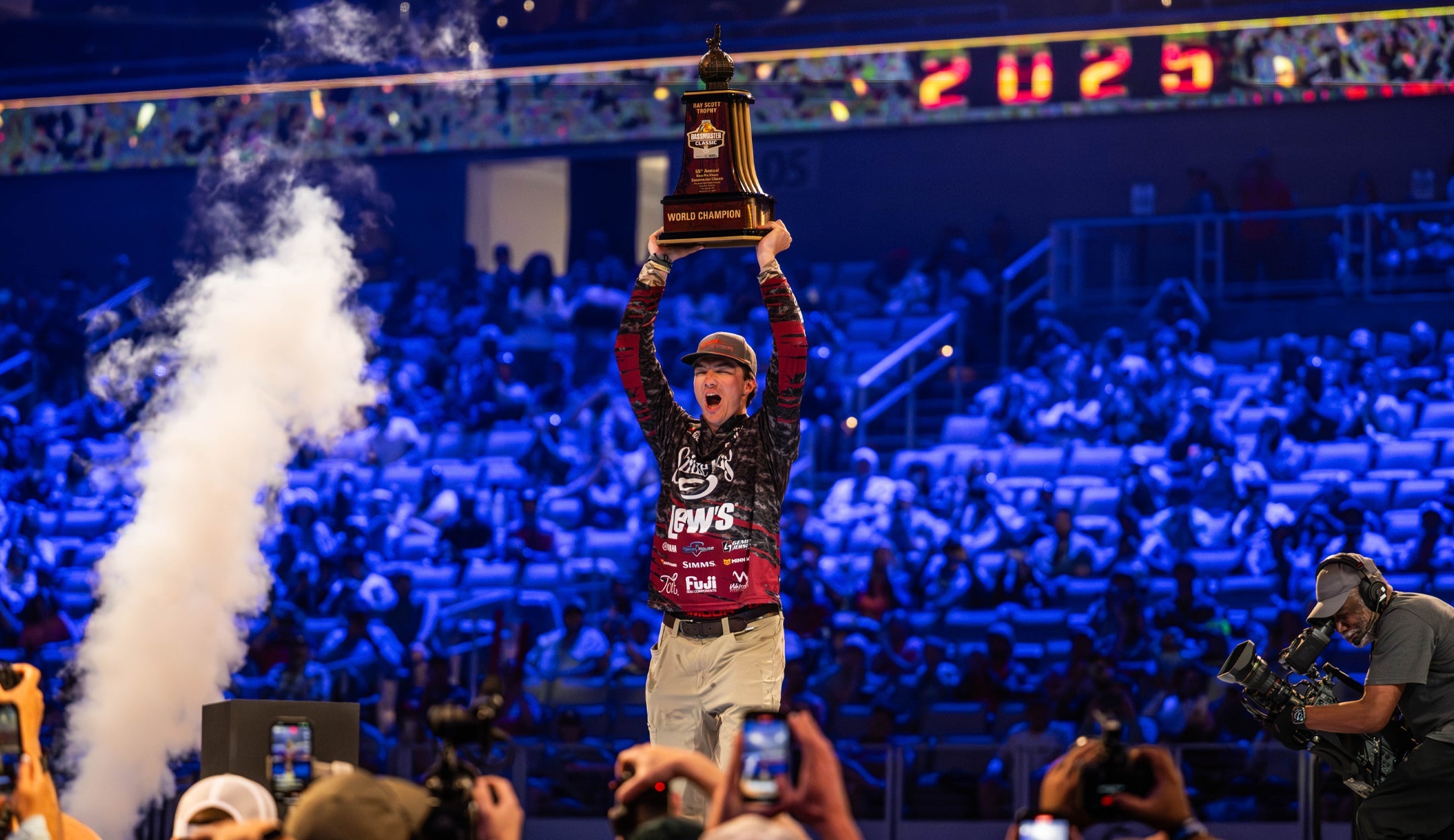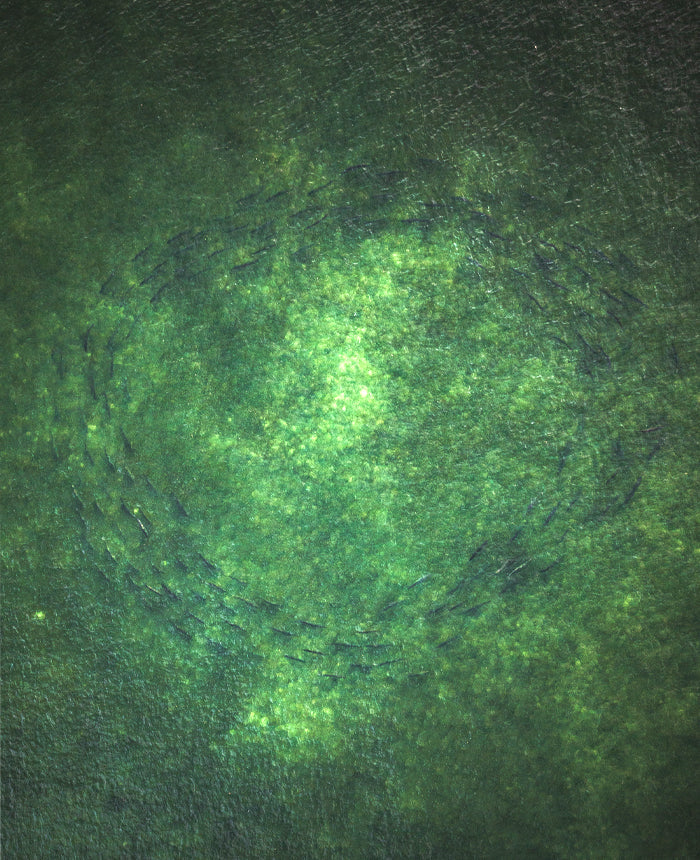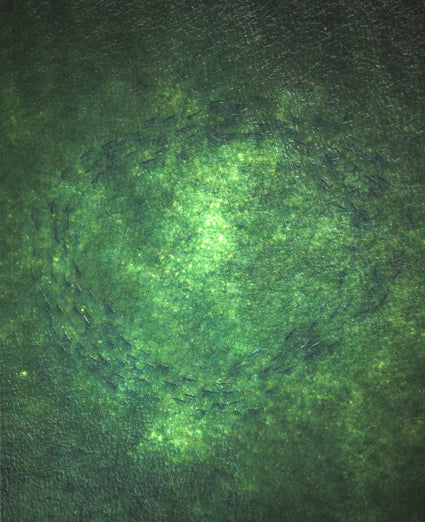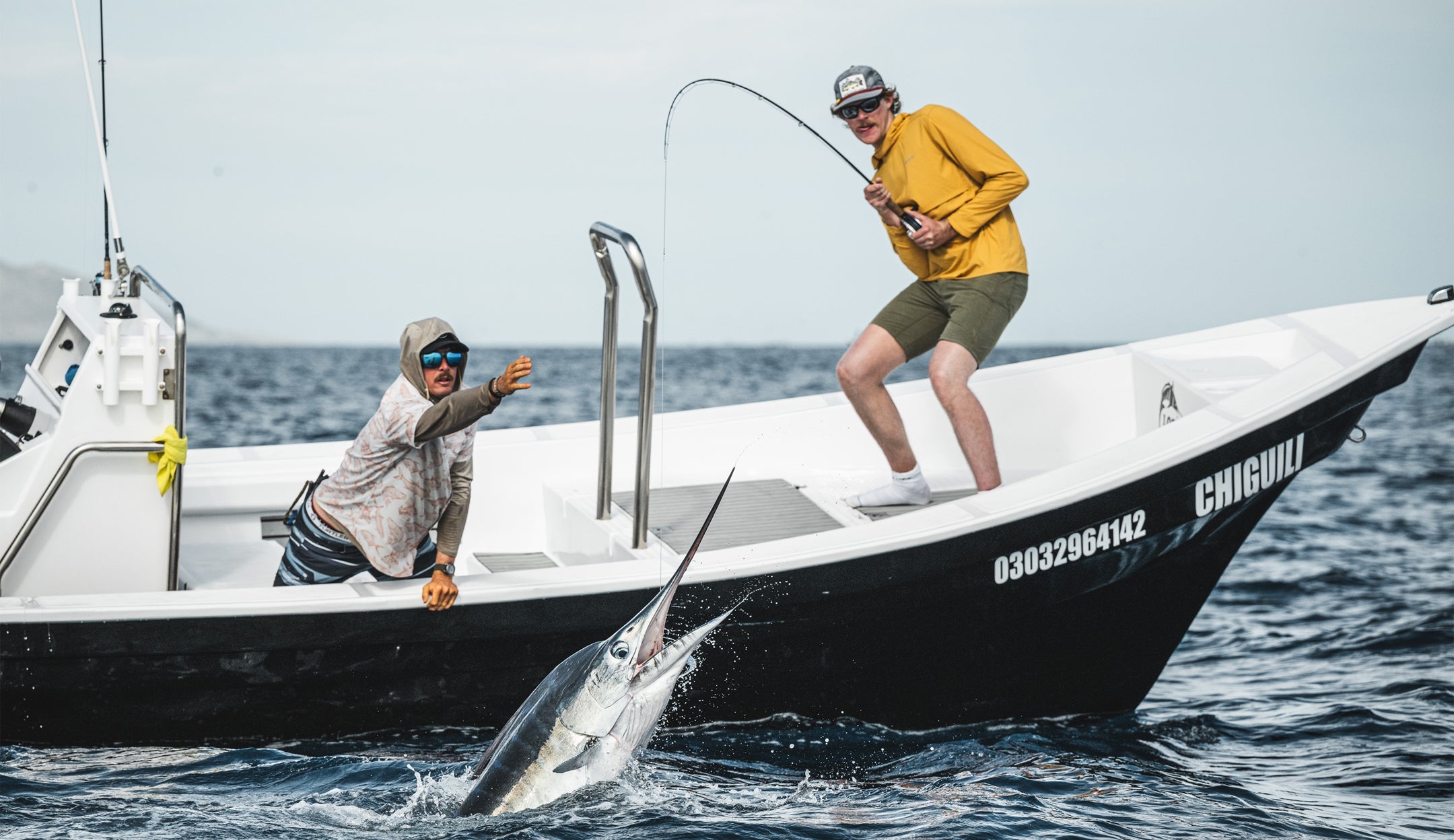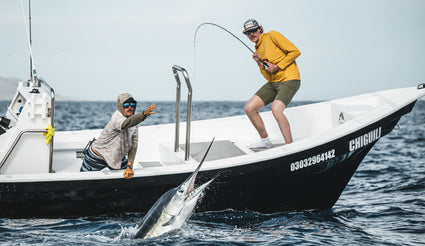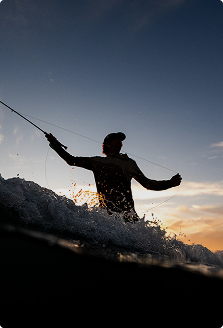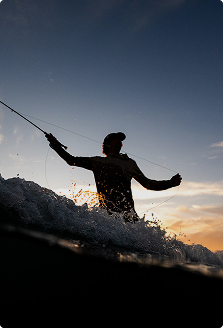When it comes to trusted voices in fishing, trust your local shop. Based in Victor, Idaho, and deeply rooted in trout country, WorldCast is more than a shop; it’s a proving ground for gear and guides. Chris Littauer’s story is one of those. What started with a dream and a station wagon pointed west has turned into a career built inside and outside the shop walls — from guiding, to managing destination travel, to now, serving as WorldCast’s vice president.
Recently, Chris put Simms’ new Flyweight Boot to the test in one of the most iconic, demanding, and rewarding fishing destinations on the planet — New Zealand. What follows is his firsthand experience chasing browns rugged backcountry, and why, after logging mile after mile, day after day, his feet never even crossed his mind — but that’s been the point all along regarding the latest iteration of the Flyweight Boot.

Simms: So let’s get into your most recent experience in New Zealand with the Flyweight Boot. I’m assuming this was not your first trip to New Zealand, is that correct?
Littauer: No, it wasn’t. It was only my second trip. However, the first time I went down, I spent three and a half months there hiking, fishing, and camping. So even though I’ve only been twice, it feels like a lot more.
Simms: When was that first long trip?
Littauer: Believe it or not, that was back in 2013. It’s interesting to have 12 years of perspective between trips, to see the maturation that’s taken place as an angler, a human, and a traveler.
Simms: I haven’t made it there myself yet, but my perception is: big, spooky, challenging browns, and arguably the best sight-fishing option for trout on the planet. Tell me about the terrain and what it’s like to chase those fish.
Littauer: Yeah, I think it’s the nature of the place that defines how you fish. It’s mountainous, rugged, especially the South Island, which is where we were. Most of it is undeveloped backcountry. The Southern Alps are a serious mountain range, and they produce a lot of terrain and a lot of water. Thankfully, much of it is accessible to the public.
Simms: “Accessible” is relative. How accessible is it by vehicle?
Littauer: Great point — and that’s where I was headed. Most of it isn’t reachable by 4-wheel drive. It’s accessible on foot. And, in my experience, to get to the best fishing, you need to be as far away from people as possible.

Simms: You were on the South Island, Yes? Tell us about the water there.
Littauer: That’s correct, the South Island has an unbelievable amount of moving water. Primarily, that’s because of the terrain and the precipitation; there’s just a ton of water, and a lot of that water holds trout. But — there aren’t a lot of trout in each river. Fish per mile is significantly lower than what we see here in the Mountain West.
Simms: Any idea why?
Littauer: I think it’s because there’s not a ton of bug life. Without that entomological density, the rivers can’t support huge populations. But these rivers are clean, cold, and clear (well, sometimes), and they’re often 2,000 – 3,000 feet above sea level. They have longer growing seasons than our Rocky Mountain rivers. So in my mind, they support fewer, but larger fish.
Simms: I’ve always heard that shots are often spaced out pretty far. So, I’d imagine you are doing a lot of walking just by nature of the fishery, yeah?
Littauer: Oh, for sure. On some stretches, in extreme cases, you might only get a shot at a fish every half mile or mile. You combine that with the rugged terrain, and it demands a lot of effort. But that’s also an aspect that I absolutely love about it.
Simms: So, in your experience, what qualifies as a good day of fishing in New Zealand?
Littauer: You’re tired. Your legs are worked. You’ve scrambled, hiked, and crossed rivers. It no doubt takes a toll. A helicopter at the end of the day is really nice, but that’s not how most anglers do it. You walk in — and you walk out. But with the scenery, the tactics, and the caliber of the fish, it’s more than worth it. The effort required is one of the biggest draws for me.
Simms: Tell us a little bit about your typical approach.
Littauer: You’re always walking upstream. These fish are incredibly in tune with their surroundings. They have no natural predators. No eagles, no otters, no bears. We’re their only predator, really. Because of that, you have to approach from downstream.
Simms: What happens if you don’t approach downstream?
Littauer: Some guides down there swear the fish can smell you. If you walk above a pool, they’ll spook just from water carrying your scent. Oil from your skin, whatever, odor from your boot, whatever. I know it sounds crazy, but they’ve tested it. It doesn’t happen with cattle or ATVs crossing above them, but if it’s human, the fish slither away. So you’re walking upstream, just surveying.

Simms: Obviously, footwear is critical for a trip like this. You brought the new Flyweight Boot. Had you used the previous model before?
Littauer: Oh yeah, I used the original Flyweight Boot and really loved it. But the new one is definitely a very positive and noticeable upgrade.
Simms: How so?
Littauer: It still has that same super lightweight feel, but now it feels way more supportive and sturdy underfoot. And honestly, it’s noticeably more comfortable, and that’s saying something, because the original was already really comfortable. But this new version? After 10 hard days of fishing, I never once thought about my feet.
Simms: Roughly how many miles a day were you putting in each day?
Littauer: On average, I’d say about six to eight miles a day. And again, never once did I think about my feet. And that’s really rare for a wading boot. Usually, with that kind of walking, something eventually bothers you, a stiff ankle cuff, toe pressure, heel rub, whatever. But with the new Flyweight, no issues at all. And for obvious reasons, that’s huge on a trip like this.
Simms: What about slip-resistance? The lug pattern changed quite a bit.
Littauer: Yeah, New Zealand wading can be like ice skating, depending on the river. You’re crossing constantly, trying to get to the high-probability water, avoid getting cliffed out and so on and so forth. On a typical day, you might cross a river a dozen times or more.
Simms: Did you use studs?
Littauer: We brought them, but a lot of the guides didn’t want us to use them. They’re trying to keep things as stealthy as possible, and worry that the metal scraping and tapping on rocks might spook fish. So we didn’t use them at all. There were a few sketchy rivers and moments for sure, but the new outsole really held up and did great. So good that I never really felt like I had to put them in. I figured we’d get out there and eat it the first day, and I’d go back and stud up my boots, but we never did.
Simms: For a place like that, weight really matters, but of course, so does durability. What did you think?
Littauer: Definitely more durable. You can see it, and you can definitely feel it. It still feels very light, but it’s clearly beefed up. It’s just a much more solid and supportive feeling boot all the way around.. The materials on the upper seem to be way more abrasion-resistant. And structurally, it just feels like a more serious boot.
Simms: So, after 10 days of beating them up, what shape are they in?
Littauer: No breakdown whatsoever. Sure, they’re showing signs of use, but no weak spots, no damage, no worries. They don’t look new, but they look like they’ll last another five years, and for someone like me, that’s saying a lot.
Simms: That’s high praise for a lightweight boot. Did you pair them with waders or wet-wading socks?
Littauer: We wet waded, and I wore the Simms Guard Sock with them.

Simms: Any thoughts on sizing? Some folks go true to size, some size up. What do you recommend?
Littauer: I used to size up, but a few years ago, Simms must’ve adjusted the fit. I’m now true to size. I wear a 10 street shoe, and that’s what I wore in New Zealand, for both wet wading and with waders. That's also what I recommend to WoldCast customers: start with your street shoe size, and we can adjust accordingly. If someone’s planning to steelhead in the Pac Northwest with thick socks, then yeah, maybe size up, but in general, most folks are good going with a wading boot that's the same size as their street shoe.
Simms: Yeah, I really feel like any product that’s fit contributes to performance should be tried on in person. When it comes to wading boots, we recommend the consumer go into the shop with the socks and setup they intend to fish in. I’d imagine that the backcountry of New Zealand is not an ideal place to find out your boots don’t fit.
Littauer: Exactly. That’s the last place you want to be questioning your boot size. It could ruin a bucket-list trip real fast.
Simms: Last question, and by all means, be honest. Of all the lightweight boots you’ve used in your career, how does the new Flyweight stack up?
Littauer: No doubt in my mind, it’s the best I’ve used. I’m seriously impressed. Now, long-term durability takes time to test, but so far I’ve worked them pretty hard, and I have zero concerns. It hasn’t passed the 5-year test yet, but I can tell you in terms of comfort, support, and performance, it’s the best lightweight boot I’ve ever used.
